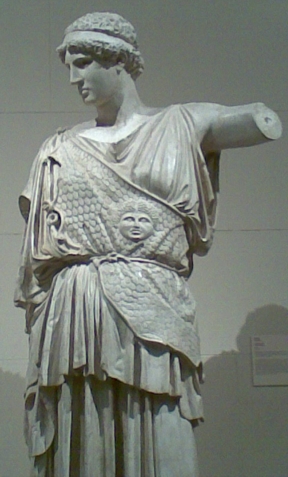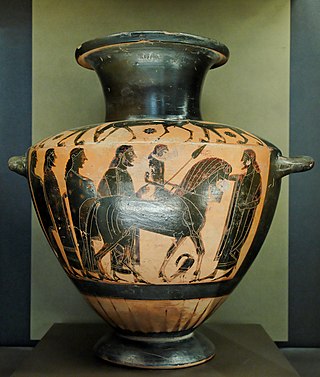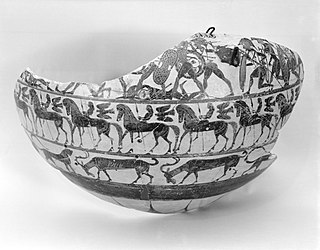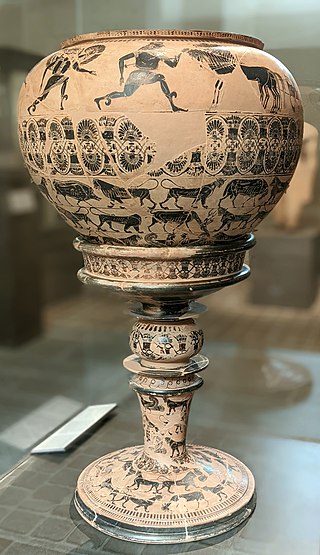
The aegis, as stated in the Iliad, is a device carried by Athena and Zeus, variously interpreted as an animal skin or a shield and sometimes featuring the head of a Gorgon. There may be a connection with a deity named Aex, a daughter of Helios and a nurse of Zeus or alternatively a mistress of Zeus.

The Corinthian order is the last developed and most ornate of the three principal classical orders of Ancient Greek architecture and Roman architecture. The other two are the Doric order which was the earliest, followed by the Ionic order. In Ancient Greek architecture, the Corinthian order follows the Ionic in almost all respects other than the capitals of the columns, though this changed in Roman architecture.

Sicyon or Sikyōn was an ancient Greek city state situated in the northern Peloponnesus between Corinth and Achaea on the territory of the present-day regional unit of Corinthia. The ruins lie just west of the modern village of Sikyona. An ancient monarchy at the times of the Trojan War, the city was ruled by a number of tyrants during the Archaic and Classical period and became a democracy in the 3rd century BC. Sicyon was celebrated for its contributions to ancient Greek art, producing many famous painters and sculptors. In Hellenistic times it was also the home of Aratus of Sicyon, the leader of the Achaean League.

Black-figure pottery painting, also known as the black-figure style or black-figure ceramic, is one of the styles of painting on antique Greek vases. It was especially common between the 7th and 5th centuries BCE, although there are specimens dating as late as the 2nd century BCE. Stylistically it can be distinguished from the preceding orientalizing period and the subsequent red-figure pottery style.

Lydos was an Attic vase painter in the black-figure style. Active between about 560 and 540 BC, he was the main representative of the '’’Lydos Group’’’. His signature, ό Λυδός, ho Lydos ", inscribed on two vases, is informative regarding the cultural background of the artist. Either he immigrated to Athens from the Lydian empire of King Kroisos, or he was born in Athens as the son of Lydian parents. In any case, he learned his trade in Athens.

In Ancient Greece, the Gorgoneion was a special apotropaic amulet showing the Gorgon head, used by the Olympian deities Athena and Zeus: both are said to have worn the gorgoneion as a protective pendant, and often are depicted wearing it. It established their descent from earlier deities considered to remain powerful. Among other attributes, it was assumed by rulers of the Hellenistic age as a royal aegis to imply divine birth or protection, as shown, for instance, on the Alexander Mosaic and the Gonzaga Cameo.

The Staatliche Antikensammlungen is a museum in Munich's Kunstareal holding Bavaria's collections of antiquities from Greece, Etruria and Rome, though the sculpture collection is located in the opposite Glyptothek and works created in Bavaria are on display in a separate museum. Ancient Egypt also has its own museum.
The Painter of Palermo 489 was an ancient Corinthian vase painter in the black-figure style; his real name is unknown. He was active during the transitional period between orientalising vase painting and black-figure proper. He is known especially as the teacher of the Columbus Painter and thus a major indirect influence on several further Early Corinthian artists, such as the Chimaira Painter and the Chimaira Group. Darrell A. Amyx describes him as "the Columbus Painter's great teacher" and a "powerful and accomplished painter". He painted mostly aryballoi.
The Columbus Painter was an ancient Corinthian vase painter in the black-figure style; his real name is unknown. He was active during the transitional period between orientalising vase painting and black-figure proper (c. 640–625 BC). He was a pupil of the Painter of Palermo 489 and, in turn, the teacher of the Chimaira Painter and thus a major influence on the Chimaira Group dominated by the latter. Characteristic are his powerful lions. He painted especially aryballoi.

Dodwell Painter was an ancient Corinthian vase painter in the black-figure style whose real name is rather unknown. He was active during the Middle and Late Corinthian periods (c. 600–550 BC) and his works dates back to 580 to 570 BC.

The Cavalcade Painter is the conventional name for an ancient Greek vase painter who produced Corinthian black-figure vases. He was active during the Middle Corinthian period, around 580 BC.

The Gorgon Painter was one of the early Attic black-figure vase painters. He was active between 600 and 580 BC. His name vase, Dinos of the Gorgon Painter, is currently on display in the Louvre and depicts Perseus fleeing the Gorgons.
The Comast Group was a group of Attic vase painters in the black-figure style. The works of its members are dated to between 585 and 570/560 BC. The artists of the Komast Group are seen as the successors of the Gorgon Painter. Its most important representatives were the KX Painter and the slightly later KY Painter. They painted vases shapes that had been newly introduced to Athens or that had not previously been painted. Especially commonly painted by them were '’kothon’’ and lekanis. From Corinth, then still the centre of Greek vase painting, they adopted the Komast cup and the skyphos (known as kotyle. The KY Painter introduced the column krater. Also popular at the time was the kantharos. The group adopted the Corinthian habit of depicting komasts, after which the group is named. It provided the group’s most commonly painted motif. The komast scenes permit Attic artists for the first time to reach the artistic levels of middle-ranking Corinthian vases. While the older KX Painter still mostly painted animals and only the occasional komast scene, the komos became a standard motif for the KY painter and further inferior successors. It is not clear to what extent the painters of the group really cooperated. It is possible that they all worked in the same workshop. The group influenced later Attic vase painters, including the Heidelberg Painter. Works by the Komast Group were not only found in Attica, but appear to have been exported widely. Vases and fragments have been found at many sites, including Naukratis, Rhodes, Central Italy, Taras, and even Corinth.

The KX Painter was an Attic black-figure vase painter. He was active between 585 and 570 BC. Besides the KY Painter, the KX Painter was the main representative of the Comast Group, which succeeded the Gorgon Painter. His conventional name was allocated by John Beazley. He is considered the better and chronologically somewhat earlier representative of the group. He was the first painter in Athens to occasionally depict komasts on his vases, a motif adopted from Corinthian vase painting. He mainly painted skyphoi, lekanes, kothones and Komast cups. In contrast to later representatives of the group, he still mostly painted animals, in a more careful and powerful style than the Gorgon Painter. Some mythological scenes by him are also known. Especially famous are his small-fornat mythical scenes placed within animal friezes. The KX Painter can be considered the first Attic painter to achieve a quality at par with that reached in Corinth, then the dominant centre of Greek vase painting. Imitations of his works are known from Boeotia.

The C Painter was one of the most important Attic black-figure vase painters. His works date to circa 575–550 BC. His conventional name was allocated by the archaeologist John Beazley. The C stands for "Corinthianising", a reference to the strong influence of Corinthian vase painting on the artist. He was successor to the Comast Group and used the relatively old-fashioned range of vessel shapes preferred by that group, including lekanis, tripod kothon and skyphos. In contrast, he also painted quite innovative lekythoi with pronounced shoulders, although the more conservative Deinaeira type was still in use by some workshops at his time. The C Painter was the first Attic vase painter to paint cups without an offset lip, the Merrythought cup.

The Little masters were a group of potters and vase painters who produced vases of the Attic black-figure style featuring well-done figures in miniature. They were active in Athens approximately 560–530 BC. They mainly produced Little-master cups: lip cups, band cups, and droop cups, but were not entirely limited to such shapes. The group includes:

The Lysippides Painter was an Attic vase painter in the black-figure style. He was active around 530 to 510 BC. His conventional name comes from a kalos inscription on a vase in the British Museum attributed to him; his real name is not known.

The Dinos of the Gorgon Painter is an important example of ancient Greek pottery, produced at Athens around 580 BC. It entered the Louvre's collection in 1861, with the purchase of Giampietro Campana's collection.

The Chimera Painter was an anonymous Corinthian black figure vase painter active c. 600-575 B.C. He is named for the Chimera depicted on one of his works, which is now in Vienna. The artist was likely a student of the Columbus Painter, who in turn was a student of the Painter of Palermo 489. His work displays strong Near Eastern influence; the influence of Assyrian art is particularly visible in his depictions of lions.
















